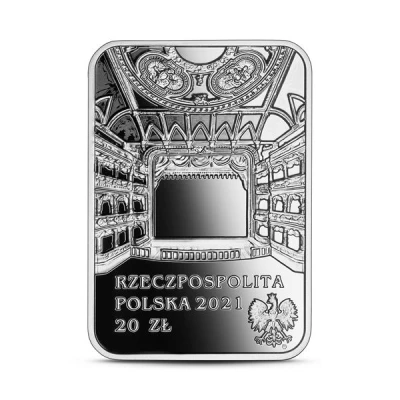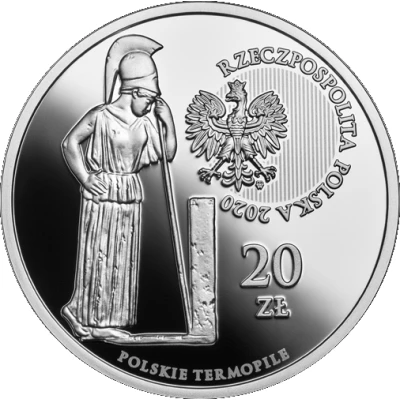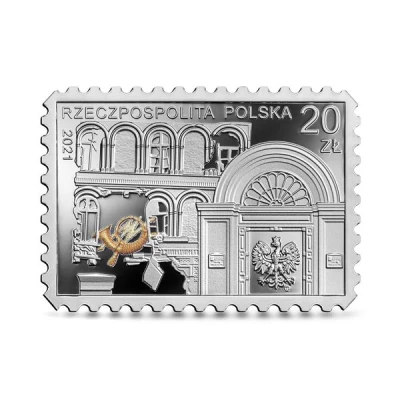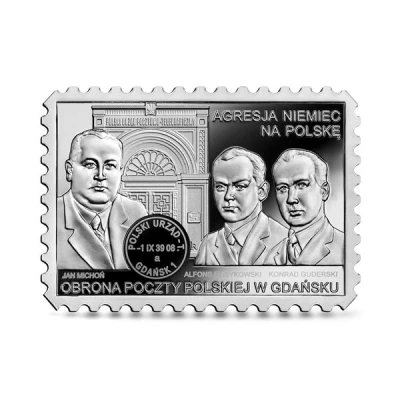


© Narodowy Bank Polski
20 Zlotys Gabriela Zapolska
2021 year| Silver (.925) | 28.28 g | - |
| Issuer | Poland |
|---|---|
| Period | Third Republic (1989-date) |
| Type | Non-circulating coin |
| Year | 2021 |
| Value | 20 Zlotys (20 Złotych) 20 PLN = USD 5.08 |
| Currency | Fourth Zloty (1995-date) |
| Composition | Silver (.925) |
| Weight | 28.28 g |
| Shape | Rectangular |
| Technique | Milled |
| Updated | 2024-10-07 |
| Numista | N#310315 |
|---|---|
| Rarity index | 94% |
Reverse
Script: Latin
Designer: Dominika Karpińska-Kopiec
Comment
Gabriela Zapolska, (née Maria Gabriela Stefania Korwin-Piotrowska, (first married name Śnieżko- Błocka and second married name Janowska). She was born in Podhajce on 30 March 1857 and died in Lviv on 21 December 1921. Active as an actress, stage director, theatre manager, writer, and columnist, she was one of the most distinctive representatives of Polish culture of the late 19th andearly 20th century and is considered to be the most accomplished Polish playwright of her time. She came from a moderately affluent family of landed gentry. At the age of 19, she was married off to Konstanty Śnieżko-Błocki who was an officer in the Tsarist army. The unhappy marriage was short-lived and left a deep mark in Zapolska’s psyche. In 1881, she made her literary debut by publishing the short story Jeden dzień z życia róży in the newspaper “Gazeta Krakowska”. From November 1879 to April 1880, she performed on stage in the amateur theatre of the Warsaw Philanthropic Society (Warszawskie Towarzystwo Dobroczynności) under the name Gabriela Śnieżko. After separating from her husband, she started using the artistic pseudonym of Gabriela Zapolska. In 1882, she made
her professional stage debut at the Kraków theatre (currently the Helena Modrzejewska National Stary Theatre in Kraków) in the small role of Margot in Kazimierz Zalewski’s comedy Spudłowali. From 1882 to 1889, she performed in provincial theatres, as well
as at the theatres in Lviv and Poznań. In Kraków, she made a guest appearance in the role of Nora, the eponymous character in Henrik Ibsen’s play (1889). She unsuccessfully sought employment at the Warsaw Theatre Directorate (Warszawskie Teatry Rządowe). Despite Zapolska’s literary success, the continued setbacks in her personal life and acting career led the artist to a nervous breakdown
concluded with an unsuccessful suicide attempt.
In the years 1889-1895, Zapolska lived in Paris, where she studied the art of acting and performed at AndréAntoine’s famous Théâtre Libre and, occasionally, at the Théâtre de l’Oeuvre. While she did not achieve success in France, she learned a lot from her stay abroad.
Zapolska became fascinated with the innovative trends of naturalism and psychologism in the European theatre, as well as the realistic acting style. She drew from this experience in her later professional life. After returning to her homeland, Zapolska went back to
performing in the provinces. However, already in 1897, theatre manager Tadeusz Pawlikowski engaged her to join one of the best Polish theatrical groups – the Municipal Theatre in Kraków (currently the Juliusz Słowacki Theatre in Kraków). Pawlikowski was appreciative of
Zapolska’s acting skills as well as her literary talents. He successfully staged her well-crafted, bold dramas portraying the lives of the poorest members of society, the Jewish community (Jojne Firułkes, Małka Szwarcenkopf), as well as the bourgeoisie, which was depicted by Zapolska in a highly critical manner (Dziewiczy wieczór, Żabusia). Moreover, the plays presented on the stage of
the Municipal Theatre also included politically engaged dramas such as Sybir and Tamten, which related to the developments taking place at the time. Due to fear of reprisals on the part of the partitioning powers, the latter work was written under the pseudonym Józef Maskoff. In 1899, Zapolska moved to her hometown of Lviv and from that point on she primarily devoted herself to writing. In 1901, she married the painter Stanisław Janowski and once again moved to Kraków. She founded a private acting school and the innovative
Independent Theatre (Scena Niezależna), which was modelled on Antoine’s theatre. She returned to Lviv in 1904, and in the years 1907-1908 led her own theatre there. Her novels, short stories, and stage plays enjoyed widespread popularity, and the tetralogy of stage plays consisting of the dramas Żabusia, Ich czworo (Four of Them), Skiz (The Secret of Skiz) and Moralność pani Dulskiej (The Morality of
Mrs Dulska) belongs to the canon of Polish drama. Because of these works, Zapolska is frequently referred to as a feminist. Although she rejected such characterisations herself, her work represents one of the most courageous and incisive approaches towards women’s issues and social issues in all of Polish literature.
Interesting fact
The Gabriela Zapolska 20 Zlotys coin is a non-circulating coin, meaning it is not intended for general circulation and is instead produced in limited quantities for collectors.
Price
| Date | Mintage | VG | F | VF | XF | AU | UNC |
|---|---|---|---|---|---|---|---|
| 2021 MW | 10000 | - | - | - | - | - | - |
Values in the table are based on evaluations by sales realized on Internet platforms. They serve as an indication only for 20 Zlotys (Gabriela Zapolska) 2021 coin.



